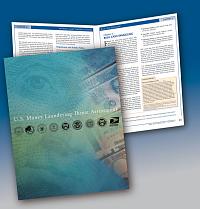
Search
Info Updates
National Threat Advisory
Elevated
![]()
Significant Risk of Terrorist Attacks
Report Suspicious Activity:
1-866-DHS-2-ICE1-866-347-2423
Information for families of ICE detainees:
Contact InformationPublic Information
The Cornerstone Report: Volume 3, Issue 1ICE Expands Financial Investigations to Combat Growing Money Laundering Threats
|
 |
ICE’s innovative efforts and growing commitment to combat money laundering threats were highlighted at a Washington, D.C. ceremony January 11 where Assistant Secretary Julie Myers participated in the unveiling of the first national Money Laundering Threat Assessment.
Since ICE was created in 2003, the number of arrests resulting from ICE financial investigations has increased from 1,224 in FY03 to 1,567 in FY05. The number of indictments has increased from 865 to 932, and the number of convictions has increased from 703 to 823. In total, ICE financial investigations have resulted in the seizure of more than $477 million over the past three fiscal years.
The increases stem, in part, from the expansion of ICE’s financial authorities to address human smuggling and other immigration violations. ICE agents routinely include financial components to most types of criminal investigations, including narcotics smuggling and trafficking, alien smuggling and human trafficking, weapons smuggling, export enforcement, commercial trade fraud, intellectual property rights (IPR) enforcement, cyber crimes, immigration document and benefit fraud and human rights violations. Prior to the creation of ICE, there was no systemic U.S. effort to target the financial infrastructure of human smuggling and trafficking organizations. Today, ICE is combining its financial and immigration authorities in a coordinated campaign against these groups. The amount of assets seized by ICE in these cases has jumped from almost nothing in FY03 to $34 million in FY05 and $22 million during the first three quarters of FY06.
ICE has achieved success in its anti-money laundering efforts by using an approach that focuses on the underlying financial systems most vulnerable to exploitation. These systems are all identified in Money Laundering Threat Assessment.
The following are examples of how ICE is addressing some of these threats.
Money Services BusinessesFor decades, money service businesses (including money transmitters and hawalas) have proven vulnerable to criminal exploitation. The USA PATRIOT Act of 2001 enhanced ICE’s ability to combat the international movement of illicit funds through these businesses by amending federal statutes making it a crime to operate an unlicensed money service business under 18 USC 1960, prohibition of unlicensed money transmitting businesses.
Since the enactment of USA PATRIOT Act, ICE agents have used this statute to aggressively target unlicensed money transmittal businesses and underground hawalas nationwide because of the substantial vulnerabilities they pose. These investigative efforts have resulted in 142 criminal indictments and the arrest of more than 155 persons, as well as the seizure of more than $25 million in illicit profits.
|
|
Trade-based money laundering involves several schemes that enable dirty cash to be separated from the crime early in the money laundering process. The most common trade-based scheme in the Western Hemisphere is the Black Market Peso Exchange (BMPE), in which Colombian drug traffickers swap illicit dollars in the United States for clean pesos in Colombia.
ICE has created a Trade Transparency Unit (TTU) that employs sophisticated computer systems to analyze trade data and financial information to detect anomalies in international commerce that may be indicative of money laundering.
ICE helped create the first foreign TTU in Colombia late last year, under the auspices of Plan Colombia. Under this initiative, ICE detailed agents and provided more than 200 computers to Colombian authorities to help them develop a database for the exchange and analysis of trade data. On March 13, Assistant Secretary Myers announced that ICE was teaming up with the governments of Argentina, Brazil, and Paraguay to create new TTUs to combat trade-based money laundering and other financial crimes in their nations and in the shared tri-border area in South America.
|
|
The threat posed by bulk cash smuggling at home and abroad is growing increasingly acute. DHS, through ICE and U.S. Customs and Border Protection (CBP), plays a leading role in combating this threat.
In recent years, ICE and CBP have launched comprehensive, intelligence-driven operations targeting organizations involved in smuggling bulk currency. From FY03 through FY05, ICE agents have arrested more than 260 individuals and, together with CBP officials, have seized more than $100 million in bulk cash smuggling cases.
ICE has also been providing bulk cash smuggling training to U.S. and foreign law enforcement officers. In recent years, CBP and ICE have been sharing intelligence and providing training to Mexican law enforcement officials to combat the smuggling of currency from Mexico to other nations. This special training and intelligence-sharing operation has helped Mexican authorities seize more than $40 million in smuggled currency over the last two years. ICE is also working with CBP and the State Department to train authorities in the Middle East, Asia and Africa.
Industry Outreach and PartnershipsAn effective partnership with the private sector is critical to ICE’s efforts in combating financial crimes. Through its Cornerstone initiative, ICE is conducting aggressive anti-money laundering training and outreach with representatives from the private sector. ICE agents have delivered more than 2,800 training presentations at home and abroad, attended by nearly 50,000 representatives from the private sector, law enforcement and judicial officials.
ICE Expands Financial Investigations to Combat Growing Money Laundering Threats
Newark ICE Agents Seize $5.7 Million, Luxury Vehicles in Massive Benefits Fraud Case
Congressional Testimony from Kevin Delli-Colli Regarding “CTR Utility”
ICE Dismantles Major Narco-Money Laundering Group in Puerto Rico
Man Pleads Guilty to Operating Unlicensed Money Transmitting Business
Cornerstone is U.S. Immigration and Customs Enforcement's (ICE)
comprehensive investigative initiative for fighting financial crime, trade
fraud and intellectual property crime.
The Cornerstone Report is a quarterly bulletin highlighting key issues
related to ICE financial and trade investigations.
The Cornerstone Report covers a broad range of topics related to financial investigations and potential vulnerabilities in the financial and trade sectors.
We strive to present clear thinking by knowledgeable observers that can be read with ease and pleasure by both professionals and a general audience, and we’re happy to review unsolicited submissions for potential publication in the newsletter.
If you would like to submit an article for publication or simply find out more about how you can participate in the Cornerstone initiative, drop us an e-mail at cornerstone@dhs.gov.
1-866-DHS-2-ICE





 Frequent international wire transfers from bank accounts that appear inconsistent with stated business.
Frequent international wire transfers from bank accounts that appear inconsistent with stated business. 
